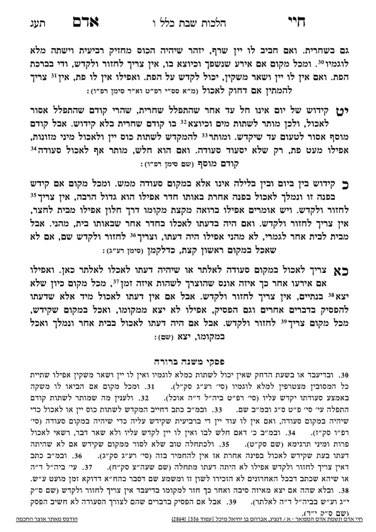The current series, which will cover Maariv on Friday night and Kiddush, is available for sponsorship. Please contact Rabbi Reingold for more information.
We are beginning siman 20, which begins the halachos of kiddush b’mokom seudah. The Chayei Adam writes that kiddush must take place in the same place as the “seudah mamish”. The Chayei Adam explains that if one makes kiddush in one corner of the room, and then decides to change to the other corner, it is still called mokom seudah because it is the same room. Nevertheless, it is not lechatchilla to do so, and one should ideally remain in the same place for the meal. If one had intent that they would be moving corners when they made kiddush, it is muttar lechatchilla.
The Chayei Adam continues, and writes that the first opinion holds that if one leaves the room, they no longer have kiddush b’mokom seudah, and even if they return to the original room, they would need to repeat kiddush.
The Chayei Adam brings another opinion, which holds that even if a person leaves the room, as long as they can see the place in which they made kiddush, it is still considered kiddush b’mokom seudah. We rely on this second opinion. “Seeing the place” includes not necessarily seeing the route which they would take to return to that place, but even if they see it through a window or the like, it is sufficient.
If one had intent to eat in a different room in the same building (the word bayis in the Chayei Adam refers to a building), even though one cannot see from one room to the other, they are yotzei. Although they should not do so lechatchilla, if they had intention to move rooms at the time of kiddush, it is sufficient. However, intention does not work to move from building to building, even if one has intent at the time of kiddush. If one ate enough at the first place such that they were yotzei kiddush b’mokom seudah, they could then eat their meal in a different building, because they were already yotzei kiddush b’mokom seudah in the first place.
The Piskei Mishnah Berurah brings that the Mishnah Berurah disagrees, and holds that even though lechatchilla, one should not move from building to building, bedieved they are yotzei.
If a person plans to eat their meal in the same place as their kiddush, but between kiddush and the meal they take a break and go elsewhere, it is also a problem and they would need to repeat kiddush. This is relevant for a sukkah, if a person’s sukkah is not adjacent to their home, and they go inside to wash after making kiddush. We will discuss this issue further in the next shiur, be’ezras Hashem.
Summary
- One should make kiddush in the same place where they plan to eat their seudah.
- If they make kiddush in one corner of the room, and want to have their meal in another corner of the same room, it is muttar bedieved. If they have intent for it at the time of kiddush, it is muttar lechatchilla.
- Similarly, if one can still see the place in which they originally made kiddush, even if they are in a different room, they are yotzei.
- If one has intent to move to another room in the same building to eat the meal, and then did so between kiddush and the meal, they are yotzei.
- One cannot make kiddush in one building and move to another building, even if they have intent at the time of kiddush. However, the Mishnah Berurah holds that one is yotzei if they had intent at the time of kiddush.



